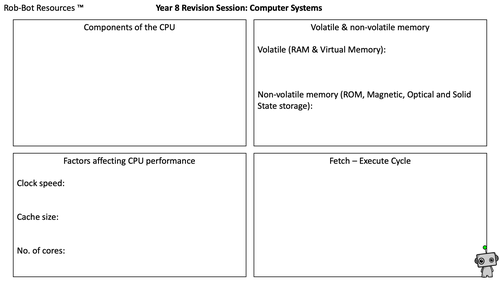


The following resources work in conjunction with KS3 Computer Science: Computer Systems Year 8. This knowledge organiser includes all the topics learned within this unit of work into one single page.
The revision sheet helps your students to prepare for the end of unit assessment while also developing independent learning skills!
Get this resource as part of a bundle and save up to 29%
A bundle is a package of resources grouped together to teach a particular topic, or a series of lessons, in one place.
KS3 Computer Science SUPER BUNDLE!
This huge bundle includes all my key stage 3 computer science units of work as well as knowledge organisers and revision sheets to help prepare your students for their final assessments (all included). Full solutions are also included. This bundle contains: * Computer Systems - Year 7 * Computer Systems - Year 8 * KS3 Networks * Computational Thinking for KS3 * Algorithm Design - Year 7 * Algorithm Design - Year 8 * Data Representation - Year 7 * Data Representation - Year 8 Also includes knowledge organisers and revision sheets and starter activities! Purchase all these resources within this bundle and you will save over 25% individual resource price!
KS3 Computer Systems & Networks
This resource bundle includes Robbot Resources Computer Systems for year 7 and 8 and my KS3 Networks & Network Security unit of work. Each resource includes a range of engaging activities, explanations and a final assessment. Answer booklets are also included for each unit of work. Also includes knowledge organisers and revision sheets to help student prepare for their end of unit assessments. Save yourself the hassle of creating your own resources and download my resources today!
KS3 Computer Systems Bundle
This bundle includes both my year 7 and year 8 Computer Systems units of work! **What you will learn within the year 7 unit of work:** * To show understanding of the difference between input and output devices with suitable examples. * To understand the difference between internal and external devices with suitable examples. * To describe the different types of storage: Magnetic, Optical and Solid State. * To understand the role and purpose of the CPU and the relationship with RAM (Fetch-Execute Cycle). * To show an understanding of an embedded system including suitable examples. **What you will learn within the year 8 unit of work:** * Explain factors affecting CPU performance. * Clock Speed * Cache Size * Number of Cores * RAM, ROM and Virtual Memory – understanding of differences between volatile and non-volatile memory. * Explain factors affecting secondary storage. * Cost * Capacity * Speed * Portability * Understand the Fetch – Execute Cycle. Both units of work include a range of information and activities to develop student knowledge and understanding of computer systems. Knowledge organisers, revision sheets and final assessments are also included. Teacher answer powerpoints for both units of work are also included. **Please leave a review!
Something went wrong, please try again later.
This resource hasn't been reviewed yet
To ensure quality for our reviews, only customers who have downloaded this resource can review it
Report this resourceto let us know if it violates our terms and conditions.
Our customer service team will review your report and will be in touch.